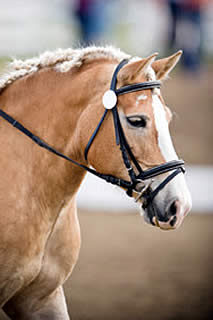If you want to ride your horse on the bit, you need to be sure that you offer an inviting, sympathetic contact. After all, he’s not going to want to step into a contact that “punishes” him.
Here’s a checklist for you to go through to make sure you offer your horse good contact.
- Firm – When you pick up the reins, feel your horse’s hind legs in your hands. You don’t want a heavy, dull pull. A pound or so is great for a horse working at Training and First Level. Think about having the weight of a grapefruit in your hands.
- Consistent – Maintain a consistent contact. You don’t want the reins to get slack and tight. Your horse won’t mind when the contact gets loose, but when it gets taut again, he’ll get a little bump in the mouth.Pretend your fingers are wrapped around the rings of the bit, and you’re “holding hands” with your partner. If you were dancing and you did a “dip”, you wouldn’t drop him because you have a consistent contact.
- Elastic – Think “E” for elastic and “E” for elbows. If your contact is elastic, your elbows move to allow for movement. Elastic contact makes it easier for you to maintain the desirable consistent contact mentioned above.–In walk and canter, elastic elbows allow for the forward and back movement of the horse’s head and neck.
So start with your elbows in “home position”. In home position your elbows are bent and about 2 inches in front of your waist so your hands are right above the withers.
Then as your horse telescopes his neck forward, straighten your arms in front of you. Then bend you elbows again to go back to home position.
Imagine how a jockey’s arms look as he gallops down a racetrack toward the finish line. That’s the look you’re striving for.
Here’s an exercise you can do. Get up in a 2-point position while in the halt. Then practice ”galloping” for the finish line with your arms. While opening and closing your elbows, sit back down in the saddle, but keep your elbows moving the same way.
–In posting trot, elastic elbows allow for the up and down movement of your body. So in this case, open your elbows like a hinge. If you get out of the saddle 4-5 inches, open your elbows 4-5 inches so your hands stay in the same place just above the withers. If you don’t open your elbows, your hands will go up and down with you as you go up and down.
To get the feeling of this “hinge-like” action, pretend that as you post “up”, your hands push your horse’s mane down into his neck.
You can also do this exercise at home. Stand behind a chair with your knees bent. Pretend you’re holding reins and rest your baby fingers on the back of the chair.
Now straighten your legs as if you’re posting while keeping your baby fingers in contact with the back of the chair. Do this several times and focus on the action of your elbows opening and closing so you can get some muscle memory for elastic elbows in posting trot.
- Symmetrical – One hand should be the mirror image of the other. Check that the thumb is the highest point of both hands, fingers are softly closed around the reins, and your hands are equidistant from your body.Carry your hands 2-3 inches apart so you can easily check that they look identical.
As an exercise, carry a crop or whip on top of your softly closed fists. Place it under your thumbs to hold it in place. Periodically check that the whip is level, and it stays equidistant from your body — particularly on circles and serpentines!
- One Bearing on the Rein – To offer your horse an even contact, pretend you have both reins in one hand.Here’s an exercise you can do:
Go on a circle in the walk, and put both reins in your outside hand. Follow the motion of your horse’s head and neck forward and back.
Imagine what that feels like in his mouth. You can only have one bearing on the rein because both reins are in one hand.
Then take one rein back in each hand and try to give your horse the same feeling in his mouth—as if both reins are in one hand.
- Straight Line Bit/Hand/Elbow – When you pick up the reins, imagine that your arms don’t belong to you anymore. They belong to your horse. Your forearms are merely extensions of the leather of the reins.Having a straight line from the bit through your hand to your elbow insures that the action of the rein can go through the horse’s body and affect the hind leg on the same side.
- Work Area – Keep your hands just over the withers. One of the most common mistakes that I see is reins that are too long and hands back over the pommel or even just above the riders’ thighs.So think: “short reins/long arms” with hands above the withers rather than “long reins/short arms” with hands behind the work area.
Jane Savoie
1174 Hill St ext.
Berlin, VT 05602
Jane’s Website
DressageMentor.com
